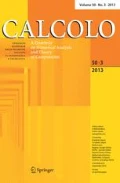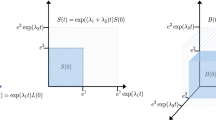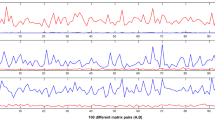Abstract
Real matrices with non-negative off-diagonal entries play a crucial role for modelling the positive linear dynamical systems. In the literature, these matrices are referred to as Metzler matrices or negated Z-matrices. Finding the closest stable Metzler matrix to an unstable one (and vice versa) is an important issue with many applications. The stability considered here is in the sense of Hurwitz, and the distance between matrices is measured in \(l_\infty ,\,l_1\), and in the max norm. We provide either explicit solutions or efficient algorithms for obtaining the closest (un)stable matrix. The procedure for finding the closest stable Metzler matrix is based on the recently introduced selective greedy spectral method for optimizing the Perron eigenvalue. Originally intended for non-negative matrices, here is generalized to Metzler matrices. The efficiency of the new algorithms is demonstrated in examples and numerical experiments for the dimension of up to 2000. Applications to dynamical systems, linear switching systems, and sign-matrices are considered.
Similar content being viewed by others
Notes
See the beginning of the next subsection.
Norms without a subscript will be regarded as an \(l_\infty \) norms (i.e \(\Vert \cdot \Vert \ \equiv \Vert \cdot \Vert _\infty \)).
For the reminder of the text, each time we mention Metzler product families or positive product families, or similar, it will be in the context of product families of Metzler matrices, product families of positive matrices, etc.
See Definition 11.
\(\gamma _i\) percent of non-zero entries are chosen from (0,1) interval, and then randomly distributed as entries of a d-dimensional vector; if the ith entry is non-zero, then it can take a corresponding negative value. All other entries are set to zero.
See Examples below.
References
Farina, L., Rinaldi, S.: Positive Linear Systems: Theory and Applications. Wiley, New York (2000)
Luenberger, D.G.: Introduction to Dynamic Systems: Theory, Models and Applications. Wiley, New York (1979)
Mitkowski, W.: Dynamical properties of Metzler systems. Bull. Pol. Acad. Sci. Tech. Sci. 56(4), 309–312 (2008)
Anderson, J.: Distance to the Nearest Stable Metzler Matrix (2017). arXiv:1709.02461v1
Logofet, D.O.: Matrices and Graphs: Stability Problems in Mathematical Ecology. CRC Press, Boca Raton (1993)
Guglielmi, N., Protasov, V.: On the closest stable/unstable nonnegative matrix and related stability radii. SIAM J. Matrix Anal. 39(4), 1642–1669 (2018)
Akian, M., Gaubert, S., Grand-Clément, J., Guillaud, J.: The operator approach to entropy games. In: 34th International Symposium on Theoretical Aspects of Computer Science (STACS 2017), Hannover, Germany. Article No 6, pp. 6:1–6:14 (2017)
Gillis, N., Sharma, P.: On computing the distance to stability for matrices using linear dissipative Hamiltonian systems. Automatica 85, 113–121 (2017)
Nesterov, Y., Protasov, V.Yu.: Computing closest stable non-negative matrix. http://www.optimization-online.org/DB_FILE/2017/08/6178.pdf. Accessed Sept 2017
Protasov, V.Yu., Cvetković, A.: The Greedy Strategy in Optimizing the Perron Eigenvalue (2018). arXiv:1807.05099
Briat, C.: Sign Properties of Metzler Matrices with Applications (2016). arXiv:1512.07043
Quirk, J., Ruppert, R.: Qualitative economics and the stability of equilibrium. Rev. Econ. Stud. 32(4), 311–326 (1965)
Roberts, A.: The stability of a feasible random ecosystem. Nature 251, 607–608 (1974)
May, R.M.: Qualitative stability in model ecosystems. Ecology 54, 638–641 (1973)
Clarke, B.L.: Theorems on chemical network stability. J. Chem. Phys. 62, 773–775 (1975)
Liberzon, D.: Switching in Systems and Control. Birkhäuser, New York (2003)
Gurvits, L., Shorten, R., Mason, O.: On the stability of switched positive linear systems. IEEE Trans. Autom. Control 52(6), 1099–1103 (2007)
Horn, R.A., Johnson, C.R.: Matrix Analysis. Cambridge University Press, Cambridge (1990)
Gantmacher, F.R.: The Theory of Matrices. Chelsea, New York (2013)
Benvenuti, L., Farina, L.: Eigenvalue regions for positive systems. Syst. Control Lett. 51, 325–33 (2004)
Blonedel, V.D., Nesterov, Y.: Polynomial-time computation of the joint spectral radius for some sets of nonnegative matrices. SIAM J. Matrix Anal. Appl. 31(3), 865–876 (2009)
Nesterov, Y., Protasov, VYu.: Optimizing the spectral radius. SIAM J. Matrix Anal. Appl. 34(3), 999–1013 (2013)
Protasov, VYu.: Spectral simplex method. Math. Program. 156, 485–511 (2016)
Cantor, D.G., Lippman, S.A.: Optimal investment selection with a multiple of projects. Econometrica 63, 1231–1240 (1995)
Kozyakin, V.S.: A short introduction to asynchronous systems. In: Aulbach, B., Elaydi, S., Ladas, G. (eds.) Proceedings of the Sixth International Conference on Difference Equations (Augsburg, Germany 2001): New Progress in Difference Equations, pp. 153–166. CRC Press, Boca Raton (2004)
Tarjan, R.: Depth first search and linear graph algorithms. SIAM J. Comput. 1(2), 146–160 (1972)
Samuelson, P.A.: Foundations of Economic Analysis. Harvard University Press, Cambridge (1955)
Levins, R.: Problems of signed digraphs in ecological theory. In: Levin, S. (ed.) Ecosystem Analysis and Prediction, pp. 264–277. Society Industrial Applied Mathematics, Philadelphia (1974)
Jeffries, C., Klee, V., van den Driessche, P.: When is a matrix sign-stable? Can. J. Math. 29, 315–326 (1977)
Maybee, J., Quirk, J.: Qualitative problems in matrix theory. SIAM Rev. 11(1), 30–51 (1969)
Acknowledgements
Countless thanks to prof V. Yu. Protasov for the hours of inspiring discussions, all the valuable remarks and the support he was selflessly giving during the writing of this paper.
Author information
Authors and Affiliations
Corresponding author
Additional information
Publisher's Note
Springer Nature remains neutral with regard to jurisdictional claims in published maps and institutional affiliations.
Rights and permissions
About this article
Cite this article
Cvetković, A. Stabilizing the Metzler matrices with applications to dynamical systems. Calcolo 57, 1 (2020). https://doi.org/10.1007/s10092-019-0350-3
Received:
Revised:
Accepted:
Published:
DOI: https://doi.org/10.1007/s10092-019-0350-3
Keywords
- Metzler matrix
- Spectral abscissa
- Spectral radius
- Perron eigenvalue
- Sign-matrix
- Dynamical system
- Hurwitz stability




